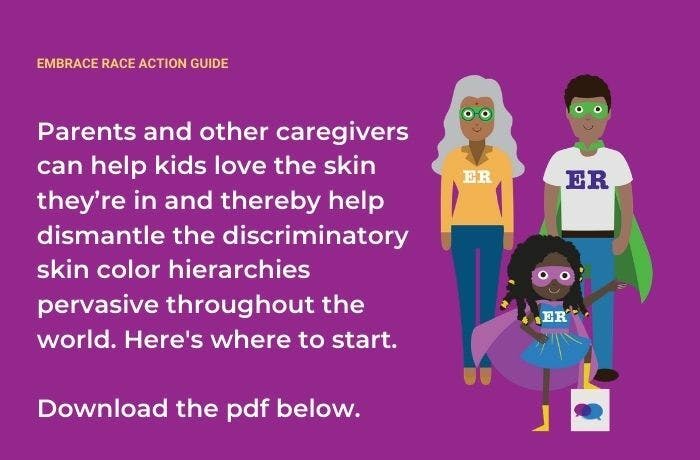Five Things to Remember to Help Keep Colorism From Infecting Your Family

Colorism operates like racism’s twin, and oftentimes children learn the rules about skin color politics at home. With the right attitude, resources and action plans, parents and other caregivers can help their kids love the skin they’re in and thereby help dismantle the discriminatory skin color hierarchies pervasive throughout the world.
1) Don’t Ignore Color.
- Research shows that children differentiate between skin colors as babies, definitely before they reach two years old. Therefore, it is natural and reasonable for a child to notice and comment on the different hues among people in their household. Help your child name the colors she sees. Help her contextualize the difference between one family member’s light skin and another’s darker tone. Or between one’s brown skin and another’s white skin. Shutting down talk about skin color sends the message that there is something wrong with skin colors being different. Don’t do that!
2) Normalize Difference.
- It’s important to normalize talking about different skin colors and be careful not to suggest that one shade is better than another. Differences in skin colors to other familiar objects, like flowers or crayons and to stress that difference just means more variety - nothing more or less. In fact, color variety can be seen as more beautiful or more useful, whether you’re talking flowers or family members!
3) Embrace Color-diverse Children’s Media.
- All children need to see diverse skin color representation as well as diverse racial representation in the books, television shows and movies they’re consuming and in the dolls and toys that they play with. If children don’t see themselves reflected in popular content, they might make the assumption that they’re not worthy of playing a starring role in their own life stories. Their peers also get those messages about who’s worthy of representation or not.The chronic underrepresentation of some races and hues hurts all children in different ways. We need to be very intentional in your media choices to right that wrong.
4) Educate yourself.
- Colorism is a global problem. There are many communities where colorism is life-threatening. If parents and caregivers are to raise children able to successfully resist colorist thinking, learning about colorism’s roots in colonialism and white supremacy - and unlearning their own skin-tone biases - are often excellent places to start.
5) Live Your Life in Color.
- As much as possible, create social circles for yourself and your family that include people of multiple hues. Make sure your children see you interacting with and embracing people of different colors. If you say all colors are beautiful and equal, but you don’t live out that truth, then your children will question the strength of your conviction.

Contributor
Lori L. Tharps
Lori L. Tharps is an associate professor of journalism at Temple University as well as an award-winning author, journalist, educator, podcast host, and popular speaker. She is the award-winning author of four critically acclaimed nonfiction books…
More about Lori L. >
Get Insights In your Inbox
Join the EmbraceRace community! You will receive the newsletter with our latest on race & kids, including upcoming events and opportunities, resources, community news and curated links.
Subscribe


